-
Posts
7,873 -
Joined
-
Last visited
Content Type
Profiles
Forums
Events
Store
Posts posted by David Von Pein
-
-
Ken,
FYI....
I just now checked the raw (DVD-R) version of my CBS-TV 11/22/63 coverage. And, just as I suspected, when I switched from one 10-minute segment to the next (when I originally put together my 85-part CBS series several years ago), I edited out most of the complete silence that accompanied the "station break" that you are referring to, so that the succeeding 10-minute video in my series wouldn't be starting off with nothing but dead silence.
I timed the "station break" in my raw version, and it lasts for exactly 66 seconds. So, yes, it was, indeed, a lot longer than the "10 second" break that Cronkite said was going to occur. But the only thing on the screen during all of that 66-second period is the static image of an American flag (which is also seen for a few seconds in the version I have put on YouTube).
And in my raw version, which I purchased from another collector in about 2009, there is nothing being said by anyone during the 66-second station break, except for the words "...is Channel 2", which almost certainly refers to WCBS-TV (Channel 2) in New York City, which is the flagship station of the CBS network. However, I think those words were mistakenly broadcast, because it's not really the complete Channel 2 voiceover I.D.
My DVD has only a portion of the "Channel 2" station I.D., leading me to think it was inadvertently put on the air over the "CBS raw feed" version of the coverage, which I am almost certain IS the version I currently have -- because there are several other instances of "dead time" during station breaks and during the "As The World Turns" soap opera that is seen before Cronkite's first bulletin. And during those other "break" times, I have nothing but a blank (black) screen in my version of the coverage, with no local announcer cutting in to identify any station at all.
Anyway, hope this helps you a little, Ken.
/DVP
-
FWIW,
Here's something else (which might not mean anything at all, but I'll add it here anyway since this "Money Order" discussion has become the quintessential example of "How to seemingly win an argument one minute, but then fall flat on your face the next". So why should I do anything to derail that lovely pattern at this point in the proceedings?

The image below comes from another one of the very obscure documents unearthed by Tom Scully deep from the bowels of the amazing Internet. I've added the black box around the relevant text concerning "large commercial banks" and "regularly exchange bundles of checks referred to as "cash letters" with each other".
To see the whole 1964 document, CLICK HERE. ....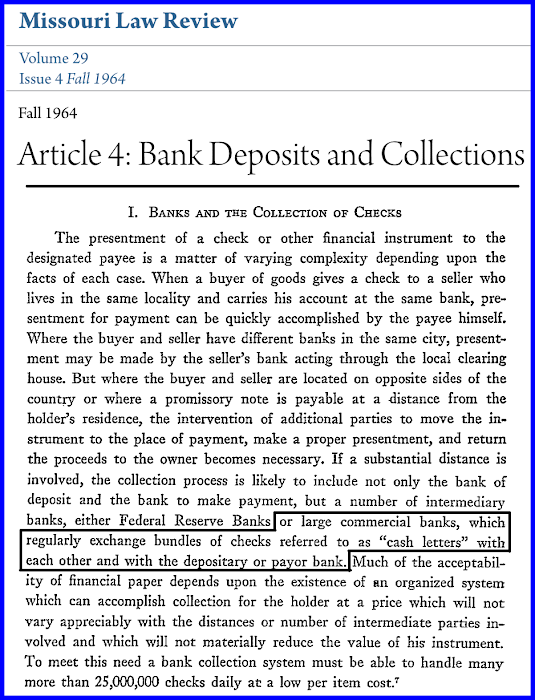
-
Mind if I borrow a couple of those Excedrin?
Sure. I've got plenty now. Since this discussion began, I've been buying it by the gross.

-
Yes, you're absolutely correct (I think), Sandy. It would appear that the 1960 document that I referred you to is talking only about the sorting methods of checks AFTER the checks (and probably money orders too) got to a Federal Reserve Bank.
If somebody can show where Sandy is wrong about what he said in his last post about "fine sorting", I'll be happy to update this part of this never-ending battle concerning "The Money Order". (Are you listening, Tom Scully? I'm sure he is.)
I must say, this lengthy debate, featuring more ups and downs than an Otis elevator, has got to be the weirdest, most incredible odyssey I've ever been associated with when it comes to any sub-topic dealing with the JFK assassination. It's simply been unbelievable.
Victory (or so it seems). Then defeat. Then a (partial) victory---or so it seems. Then the rug gets pulled out from underneath somebody yet again in the very next post. Absolutely mind-boggling. It's endless. I've never seen anything like it in all my born days here at the CIA Disinfo Center at Langley. ~wink~
But at this point--as I reach for more aspirin while I wallow in my latest defeat (or so it seems) at the hands of Sandy Larsen regarding the "fine sort" matter--I want to repeat a couple of important things that I have mentioned earlier in this saga, which are things that, in my own opinion, prove the conspiracists are 100% wrong when they cry "That money order is a fake!" ....
"The TWO most important things (IMO) that establish the 1963 Hidell money order as being a legitimate and valid document are: Oswald's writing on the money order (as determined by multiple handwriting analysts in 1964 and 1978 -- Cole, Cadigan, McNally, and Scott) and the Klein's "Pay To The Order Of First National Bank" stamp on the back of the money order. So we KNOW from the above two things that Oswald handled and wrote on that money order and Klein's Sporting Goods handled and stamped the same document. And the above two things are true, IMO, even without any other bank markings present on the document." -- DVP
And let me also repeat this comment from several weeks ago in this discussion....
"As for the lack of any bank stamps appearing on the back of Oswald's postal money order, I don't have a definitive answer to explain it. But I'd be willing to bet the farm that there IS a reasonable and non-conspiratorial answer to explain the lack of markings on the back of that document without resorting to the conclusion that the money order was manufactured and faked by a group of conspirators in a complicated and intricate effort to frame Lee Harvey Oswald for John F. Kennedy's murder." -- DVP
Thank you. And good night.

-
You're talking about the "fine-sort program," where the bank does the sorting so that the Federal Reserve Bank doesn't have to.
[...]
I think it's time for Tom Scully to eat a little humble pie. He keeps pounding on the fine-sort program, like that explains how it is that the money order hasn't any bank stamps on it. Well guess what, Mr. Scully... the fine sort program wasn't established till 1979. It was first tested in a pilot program in 1970 at the Washington-Baltimore Regional Check Clearing Center. In 1974 it was implemented at the New York FRB only. And in 1979 the program was expanded to all FRBs.
You're wrong, Sandy.
Pictured below are two illustrations dug up by Tom Scully that prove such a "fine sorting" system was in place as early as April 1960.
HERE is the 1960 source document which contains the images below.
Click to enlarge:
-
David Josephs,
That CD7 document isn't the document that Lance Payette wants to see. The document that (apparently) John Armstrong was using to support what he said on page 451 of his book "Harvey And Lee" indicates (per Armstrong) that Wilmouth gave an interview saying that a Postal Money Order would have to be stamped FOUR different times in order to be legitimate.
The CD7 document doesn't say anything about Wilmouth talking about the alleged "four bank stamps".
But if that CD7 document is actually the document that Armstrong is using to prop up his theory that money orders require FOUR different endorsement stamps, then he has significantly misled his readers, because that FBI report in CD7* doesn't say anything at all about how many endorsements (if any) should be affixed to U.S. Postal Money Orders....
https://www.maryferrell.org/showDoc.html?docId=10408#relPageId=199&tab=page
* The document seen in the CD7 link, btw, is exactly the same as CD75, which is the document that I've been linking to many times during this discussion.
CD75:
http://www.maryferrell.org/showDoc.html?docId=10477#relPageId=672But, as mentioned multiple times previously, the CD7 / CD75 FBI document does pretty much debunk all of the nonsense about the Hidell money order being a phony document. Here's what we find in that FBI report (emphasis is my own):
"Robert K. Wilmouth, Vice-President, Operations Department, The First National Bank of Chicago, Clark and Monroe Streets, furnished the following information...A deposit made with the bank on March 15, 1963, by Klein's Sporting Goods...was processed by the bank on March 16, 1963. .... The other item of $21.45 was a Postal Money Order which was sent to the Federal Reserve Bank of Chicago on March 16, 1963." -
Sandy,
Is there something that you've seen that would prohibit BOTH methods being in place -- fine sorting and a File Locator Number?
=========================
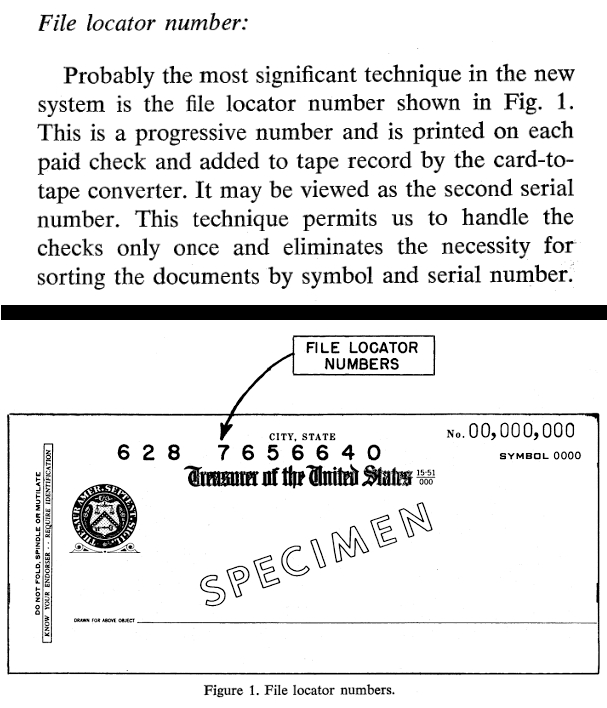
-
Regulation 16 says that non-endorsed items MIGHT be processed. Or they might be returned. What bank is gonna decide NOT to endorse their checks and then hope they aren't returned? Regulation 16 is for when accidents happen.
And that's where my Post #198 comes back into play, regarding First National possibly endorsing just ONE piece of paper that was then attached to a BULK TRANSFER/DEPOSIT of Postal Money Orders -- which is what I think probably did happen with the Hidell money order. And this type of bulk transfer is discussed by Tom Scully (who's also done some very good research on this "Money Order" topic).
An excerpt from Scully:
"Planning by the Dept. of the Treasury from at least 1957 culminated in larger banks being able to avoid burdening Fed Bank sorting and processing of large lots destined for a single payor, in this instance US Treasury issued checks and after June 1962, gradually all US postal money orders as well, since all were processed by the Treasurer's Information System and post processing were archived in the same place. This was a planned, and in March 1963, a recently implemented efficiency innovation. Big banks fine sorted the large lots of US Treasury issued checks and postal money orders in sequential serial numbers with a reconciliation data tape and a cash letter and only regional Fed Banks transport service to the Washington, DC Treasurer's ADP center. I researched and presented these planned developments."
-- Tom Scully; December 2, 2015
From the 1960 regulations Sandy posted earlier:

https://fraser.stlouisfed.org/docs/historical/ny%20circulars/1960_04928.pdf
-
Boy oh boy, I feel sorry for Sandy. Between the disaster I just created for him by citing Regulation #16 in my last post, and the previous embarrassment he suffered when he boldly declared "Here's the proof" when he first started this thread on November 12 (only to have to admit his "proof" didn't apply to the Hidell money order at all, since the Hidell M.O. was not a "Disbursement Money Order")....Sandy's having a rough November and December.

-
Important Addendum....
Well, Sandy, it looks like you overlooked this important part of those 1969 regulations. Let's look at Section 16....
"16. In the event a cash item is received by a Federal Reserve Bank from a sender without the endorsement thereon of such sender, the Federal Reserve Bank may present, send, or forward the item as if it bore such endorsement, or place on the item the name of such sender and the date of its receipt by the Federal Reserve Bank, or return the item to the sender for proper endorsement by the sender. This Bank makes the warranties stated in Section 210.6(6) of Regulation J by presenting, sending, or forwarding a cash item. These warranties arise whether or not such item bears the endorsement of this Bank."
[End Quote.]
The above paragraph makes it quite clear that a bank DOES NOT have to place its endorsement on each and every United States Postal Money Order (or "cash item") that it sends to a Federal Reserve Bank.And even though "Regulation 16" shown above is from a 1969 document, to quote Sandy....
"The regulations were essentially the same in 1969 as they were in 1960 (and 1963)." -- Sandy Larsen
======================================================
Screen capture of Regulation #16: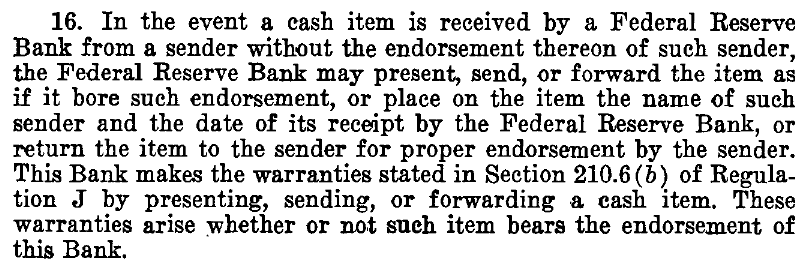
====================================================== -
Thanks, Sandy.
But as part of these sections of the regulation you cited....
"Postal money orders will be handled in accordance with an agreement made by the Postmaster General, in behalf of the United States, and the Federal Reserve Banks as depositaries and fiscal agents of the United States. .... All cash items sent to us, or to another Federal Reserve Bank direct for our account, should be endorsed without restriction to the order of the Federal Reserve Bank to which sent, or endorsed to the order of any bank, banker or trust company, or with some similar endorsement. .... The endorsement of the sending bank should be dated and should show the American Bankers Association transit number of the sending bank in prominent type on both sides."....why couldn't something like this procedure I talked about yesterday at another forum have been in place for "bulk" transfers of U.S. Postal Money Orders? Yes, it says "All cash items" in that postal regulation you cited, and it also says the cash items should be dated and should show a transit number "on both sides" (geez, imagine the time it would take to place all those markings and stamps on BOTH SIDES of each and every one of the hundreds if not thousands of Postal Money Orders that were being sent to a huge bank like the First National Bank in Chicago on a daily basis), but I'm still thinking that in the case of large bulk transfers or deposits of U.S. Postal Money Orders, this process I speculate about below was probably the way First National Bank handled the Hidell money order in 1963 (seeing as how that M.O. does not have any First National stamp on it at all)....
"I would guess that the Hidell money order was probably "endorsed" as part of a bulk batch of U.S. Postal Money Orders sent by First National Bank to the Federal Reserve Bank in Chicago.
All of the money orders in such a "bulk" transfer were going to be sent to the very same place--the FRB in Chicago, Illinois--so I can't see why a single stamped endorsement placed on a separate document (which would be attached to the bundle of bulk money orders being sent from First National to the FRB) wouldn't suffice in a bulk transaction like that, instead of having to stamp a separate endorsement on each and every money order.
I do not know for certain if such a "single endorsement on bulk transfers" procedure was actually in place at major U.S. banks in 1963, but such a process makes perfect sense to me. And it would certainly save the bank a lot of "stamping" time too.
And Tom Scully has brought up this very same topic of bulk transfers in some of his recent messages as well,
such as THIS POST." -- DVP; 12/3/15 -
Are you aware that the station break announced by Cronkite after Dan Rather's first film report on the official CBS tape lasted much, much longer than 10 seconds?Well, Ken, I suppose it's *possible* that when I first posted my 85-part series, and switched from one 10-minute segment to the next, I could have excised ("edited") a few seconds of DEAD SILENCE when the camera was focused on a static image of the American flag. Perhaps I felt that such an extensive period of DEAD SILENCE and flag viewing wasn't really necessary to retain as I went from one part to the next.I can't really recall whether I cut out a few seconds of the dead silence or not. But perhaps I did, so that the next part in my 85-part version wouldn't be beginning with 10 seconds of dead silence.But when I earlier said that "There's no missing footage", I was really thinking of footage where Walter Cronkite (or some other CBS reporter) was actually speaking and providing news. I wasn't really thinking about missing periods of DEAD SILENCE.Is the possibility of a few seconds of total silence and dead air *really* an important issue to you, Ken?If so, I must ask --- Why?** And I ask that question even though I, myself, definitely prefer all of my audio/video programs in my collection to be as "complete" and "unedited" as I can get them. But in this CBS instance, any "missing" footage amounts to pure nothingness (as far as actual "news content" is concerned). So why the need to belabor such a triviality?
-
There's no missing footage there, Ken. The "edit" you detect is merely a "splice" that I made when stringing together my earlier 85-part version of the CBS coverage (yes, 85 parts!) to make it the current 5-part version.* The splice is detectable in the audio, but there is no footage cut out at all.
* Prior to about 2011, YouTube would only allow a maximum of 11 minutes per video. But that restriction is no longer in effect, so I re-edited my 85-part (10 minutes each) series into just five parts.
-
-
E-Mail Subject: Dan Rather
Date: Nov. 27, 2015
From: David S. Lifton
To: David Von Pein
---------------
DVP:
You stated that Dan Rather reported that JFK was transferred to an ambulance. I am aware that AP reported that factoid at about 12:49 CST (approx., I’m writing this from memory), but I did not know that Dan Rather actually read that dispatch over the air.
My request: could you please point me to the source of that particular piece of sound?
Your have archived quite a few radio stations on your YouTube channel, and I have no idea which one might be the one that carried that particular report.
Could you please point me to the source?
I would appreciate that.
Thank you.
DSL
================================================
DVP's Reply:
Here it is (linked below). It's a CBS radio report by Dan Rather, with Rather saying that JFK "was taken into an ambulance and rushed to Dallas' Parkland Hospital". This occurs at the 8:57 mark of Part 1 of my WCCO-Radio (Minneapolis) series, which equates to about 12:55 PM CST:
And in video form, here's Dan Rather narrating a film and saying that an ambulance had transported JFK to Parkland (it's at the 2:13:02 mark in Part 2 of my 5-part CBS-TV series):
http://jfk-assassination-as-it-happened.blogspot.com/2012/03/cbs-tv.html
DVP
================================================
DAVID VON PEIN NOW SAYS (ON DECEMBER 2, 2015):
FYI for David Lifton....
I thought David might want to know of another instance in which a TV reporter said that JFK had been taken to Parkland Hospital in an ambulance. I noticed today in my NBC-TV coverage that Chet Huntley of NBC News also erroneously reported very early in the NBC coverage on 11/22/63 that the wounded President had been "transferred to an ambulance". That clip with Huntley comes 10 minutes and 35 seconds into Part 1 of my new high-quality version of the NBC assassination coverage (below), which equates to about 1:00 PM Dallas time.
================================================
Addendum:
Walter Cronkite of CBS also mentions the "ambulance" in his second bulletin that aired on CBS-TV at 12:43 PM CST. So I'm guessing that I could easily find similar references to the same incorrect AP report about the ambulance on ABC as well. If one network was saying it, you can bet they all were.
-
Book review by Barry Ryder of the U.K.:
http://www.amazon.co.uk/review/R39UNZ3EJHRI25
My favorite highlights....
" 'Prayer Man' begins to wobble and shake as early as page seven.
[...]
Oswald repeatedly told his interrogators that he was variously on the first and second floors of the TSBD during the murder. At no time did Oswald claim that he was 'outside'. Worse still for [sean] Murphy's 'theory' is the plain fact that when questioned by Inspector Thomas Kelly [sic] of the U. S. Secret Service, Oswald said that he did not view the parade. "I asked him [Oswald] if he had viewed the parade and he said he had not." (First interview of Lee Harvey Oswald, p2, last paragraph.) (WCR p 627). How does Murphy deal with this? Simple. He flatly declares on page 182 that [Kelley's] statement is, "..an almost certain interpolation..". In other words, [Kelley] just made it up.
As the book unfolds[,] it becomes clear that Murphy's basic method of identifying Oswald as Prayer Man is his own process of elimination. He seeks to identify as many known people as he can in the photographs and, thus, he 'eliminates' them as candidates. Whoever remains 'unidentified' must be Oswald, he claims. This approach is arbitrary and subjective; it has no scientific merit.
[...]
Murphy attributes all manner of nefarious actions to Truly and Baker and flatly accuses them of lying about where they 'really' encountered Oswald. This method is as old as the hills; everybody involved - except Oswald - was lying. Murphy actually accuses Wes Frazier of lying about Oswald's (supposed) presence in the doorway (p.171). How mad is this?
[...]
The book's author, Stan Dane[,] jumps into the narrative with frequent glee, applauding Murphy's "..reasoning and logic..", which he feels, "..at times borders on genius" (p. 92). He squeals with delight at "Sean Murphy's logic, intellectual curiosity, and exceptional research.." (p. 128). On page 136, Dane notes that,"Sean's like an expert plate-twirler - he's keeping lots of different parts of the story "twirling" simultaneously. " He sure is. The twirling plates seem to have beguiled and bamboozled Dane into a drooling state of sycophancy. Dane actually admits as much on page 215, "I am spellbound by Sean's reasoning and logic here." Yes, Stan, it shows. " Sean is a prophet here." (p 179). "And I say to you, Mr Murphy, what brilliance!" (p 246). It's all rather childish and yucky." -- Barry Ryder; November 29, 2015
http://www.amazon.co.uk/review/R39UNZ3EJHRI25
[End Quotes.]
Bravo, Barry.
========================
RELATED LINK....
OSWALD, THE DOORWAY, BOOKHOUT, FRITZ, AND HOSTY:
http://jfk-archives.blogspot.com/2015/10/jfk-assassination-arguments-part-1052.html
-
Sandy,
Re: your last "bleed-thru" post....
OK, thanks for the info.
-
I bought some 60s era punch-card MO receipts on eBay to do some tests. I couldn't get the bleed-thru seen on the Hidell MO to occur on standard 3" x 5" cards, which are the same thickness as punch money orders (7 mils). Maybe bleed-thru will be worse on the authentic card stock.
The bleeding ink is harder to understand than the missing stamps.
How much pressure did you use when you placed the ink on the paper when you did your test for bleed-thru on the money orders you said you tested?
Here's my previous exchange with Jim DiEugenio on this issue. Do neither of my possible explanations fall into the category of "reasonable explanations", Sandy? ....
JAMES DiEUGENIO SAID:
I mean the bleed through. I don't see how it can be ignored.
It really does seem to me to be a big faux pas, one which the WC apparently swallowed.
I mean can someone explain it innocently?
DAVID VON PEIN SAID:
Sure. There must have been a "heavier hand" being applied by both Lee Oswald (whose written words are bleeding through just a little bit on the CE788 money order) and the postal employee who stamped the M.O. in the lower right-hand corner. More pressure on the pen or the inked stamp means more ink being absorbed by the paper. Hence, it bleeds through to the other side.
If the 1961 money order mentioned earlier by John Armstrong has no bleed-thru, and IF it was the exact same thickness of paper stock as CE788 (which I don't suppose can ever be confirmed with 100% certainty), then I suppose that would indicate the people who wrote on and/or stamped that 1961 money order just didn't apply as much pressure as Oswald and the post office clerk applied to the CE788 money order on March 12, 1963.
[...]
Plus, it's also possible (I suppose) that between 1961 and 1963, a lighter weight and thinner paper stock was being used for U.S. Postal Money Orders, which would, of course, lend themselves more to "bleed-thru".
-
Thanks for doing that David. It makes it less likely that some important information will somehow vaporize. For example if somebody gets banned and has all his posts deleted. (I hate that [when] that happens. Not the banning part, but the deleting part.)
Exactly, Sandy!
And that is a big reason why I like to "archive" everything I post at my own Blog site. For safe-keeping. (But there's always the Wayback Machine [at Archive.org] that can retrieve many pages of Edu. Forum threads that have been deleted. But it can't retrieve anything beyond "Page 3" of a thread, unfortunately.)
-
Well, it's just speculation on my part of course. But it seems like somebody could buy a money order, cash it, then request a copy. After that, buy another money order, and bribe the postal worker to pre-date it. (Or if they have a postal worker friend, have him do it.) Then have an expert handwriting forger put Oswald's handwriting on the form. Finally, get a rubber stamp made and stamp a fake file locator number on it. Oh, one last thing... get a Klein's endorsement stamp made and stamp the back.
But at the moment I don't think that is what happened, because it appears to me that the money order was actually made on regular paper, not the real card stock. Because the ink has bled through all over the place. Why anybody would fabricate a money order on regular paper, I have no way of knowing. And it makes no sense to me. But that's what appears to have happened. I have a hard time believing that the bleed-thru that we see is actually due to the MO getting wet, as Lance notes has been suggested.
Actually, I can think of one reason why regular paper might be used. If the intention was to merely provide photographs to the authorities, not a real money order, using a photocopier to make the MO could be handy. It could be retouched and then photocopied again, and repeated if necessary. When finished, a photo is given to the WC.
If this were the case, one would have to explain how it was that somebody actually held and carried the MO from Alexandria, or wherever it was the MO came from. I don't know the details enough to determine if that was feasible.
As I said before, Sandy, when you have to go through THAT MANY wholly unprovable (and, frankly, crazy) contortions in order to make that money order a "fake" M.O., isn't it just time to admit the obvious? -- I.E., that Lee Oswald, with his own handwriting, purchased a regular money order at the post office in Dallas on 3/12/63 and then mailed it to Klein's, who then, in turn, stamped it with their "Pay To The Order" rubber stamp and sent it on to their bank in Chicago, who then, in turn, sent it on to the next stop (the Federal Reserve Bank in Chicago; despite the lack of a "First National" stamp on the M.O.; but it seems pretty obvious to me that such a stamped endorsement was not required for U.S. Postal Money Orders in March 1963), with the FRB in Chicago then sending the M.O. on to its final resting place in Alexandria/Washington.
Sandy, do you really think there are truly more reasons to believe the Hidell money order was fraudulent than there are reasons to believe it was a legitimate document that made the normal, non-sinister journey I just laid out above?
-
BTW, speaking of Tom Scully, I'm impressed by what he has dug up. I assume he was the one who dug it up... I had a hard time following his long posts. Plus I saw quotes and nothing stating who is being quoted. And in one post he speaks of himself in the third person. Very confusing.
Yes, Sandy, I agree that Tom Scully's posts and large number of linkages can be a bit confusing and hard to follow. But even though I have disagreed strongly with him in the past (he's a hard-nosed CTer, btw; he's not an "LNer" by any means), Scully has done some great work in digging up information on *this* "money order" topic to be sure. (As have Sandy Larsen and Lance Payette as well.)
FWIW / FYI....
I've archived about 80% to 90% of this rambling, rollercoaster "Money Order" discussion at my own website (at the link below), which includes discussions funnelling in from four different forums where I've been involved in discussing it with various people. I've tried to make all the material coherent and readable as I copied it to my site as the debate continued in chronological order during the last several weeks.See the 13 source links at the bottom of the page to read 100% of all discussions. Although I doubt anyone with a life would possibly want to subject themselves to that kind of Tedium Overload. But I've included all of the forum source links anyway, just for "completion" sake....
jfk-archives.blogspot.com/2015/10/jfk-assassination-arguments-part-1058.html -
Worth repeating....
"How did the money order get to the Federal Records Center in Alexandria, Virginia, if it wasn't cashed and then processed by SOMEBODY? Did a money order with the name "A. Hidell" on it suddenly fall from the sky and into the Records Center building in Alexandria?" -- DVP; 11/9/15
Or are we supposed to believe that CD87 (below) is ALSO a fake document filled with lies?....
http://www.maryferrell.org/showDoc.html?docId=10490#relPageId=119
As well as CD75?....
http://www.maryferrell.org/showDoc.html?docId=10477#relPageId=672
In other words, how many layers of confirmation are needed in order for CTers to be satisfied that Lee Oswald purchased the CE788 money order and it ended up just where it supposed to end up---at the Federal Records Center in Alexandria, Virginia?
-
I am in no way misleading people. All I've done is quote regulations and laws from official documents.
Well, Sandy, the way you got the "Disbursement Money Order" thing completely wrong was certainly a bit misleading. Although I don't think for a second that you were *deliberately* trying to mislead anybody. You, just like me and everybody else except Hank Sienzant, simply didn't scroll back to the previous page in the postal regulations you cited.
But there's no way you were intentionally trying to pull the wool over anybody's eyes, because who in their right mind would try to do something like that while at the same time providing a link with information that proves he's dead wrong (which Sandy provided in this thread)?
-
Well, since every last thing connected with the JFK evidence COULD have been fake, then what's the use of even pointing out the "evidence" against Oswald at all?
Such talk about everything being fake or manufactured borders on the insane with a lot of Internet conspiracy believers.
It's been proven that there's a "File Locator Number" on the Hidell money order (just as there should be)....so the CTers move the goalposts and now claim that the FLN is fake too (in addition to the PERFECT Oswald handwriting on the money order too, remember, which many CTers also insist was forged onto the M.O.; and it was such a perfect forgery, it fooled EVERY single handwriting expert who ever testified about the writing on the M.O. for the WC and HSCA; and those experts, remember, had the ORIGINAL money order to examine, not just a copy).
And there's Waldman #7, which many CTers insist was ALSO a forgery, of course, even though that document was pulled from the files of Klein's in Chicago by Klein's personnel on 11/23/63. (I guess the Klein's people were "in" on the plot too.)
In short, when someone needs to jump through so many different "It Was Fake" hoops, it's my opinion that it's probably a good sign that the person jumping through all those hoops is wrong---and Oswald was just flat-out guilty AND ordered that rifle from Klein's Sporting Goods, which is exactly what the sum total of evidence clearly indicates--and proves beyond a reasonable doubt.


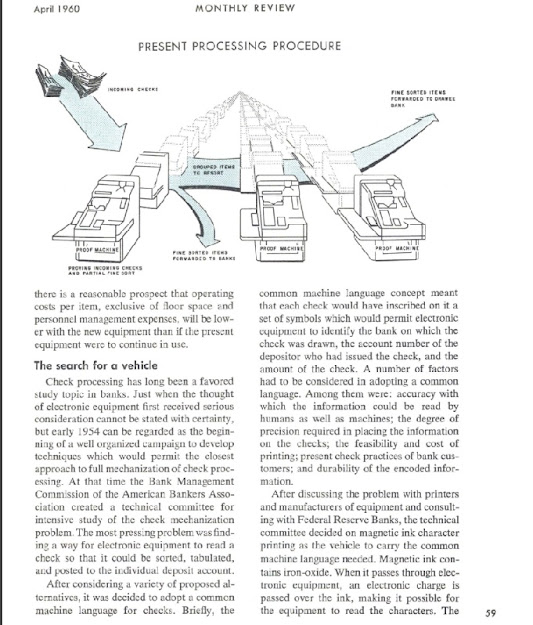
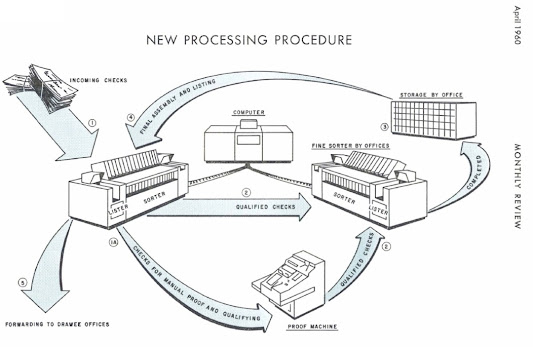
Yes, postal money orders do require bank endorsements!
in JFK Assassination Debate
Posted · Edited by David Von Pein
And so, Jim, let's see if you (or your hero, John Armstrong) can defeat by FAR the biggest VICTORY for the "Money Order Is Legit" side in this whole discussion --- the File Locator Number, which is a number we KNOW (via Lance Payette's excellent work) is only stamped on a check or money order AFTER it reaches the Federal Reserve Bank.
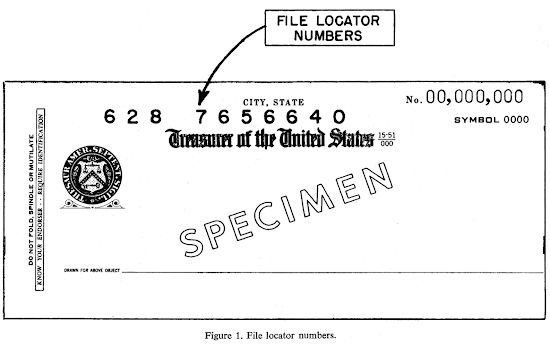
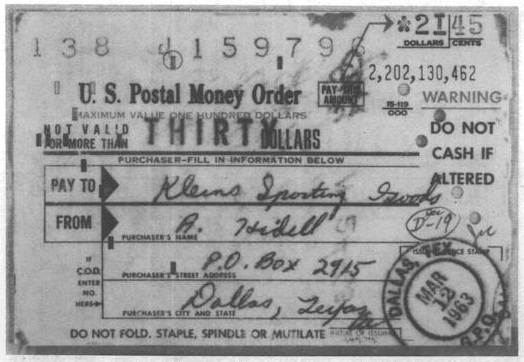
Good luck proving the FLN seen on Oswald's M.O. is a forgery, Jimmy. Not to mention the other THREE things that pretty much prove that CTers are dead wrong about the M.O. being fraudulent --- (1) Oswald's own writing on the subject M.O.; (2) the Klein's stamp on that same document; and (3) the fact that the money order was found on 11/23/63 in just exactly the place where you'd expect to find it if it had gone through the proper banking channels--the Federal Records Center in Alexandria, Virginia.
Have fun proving ALL of that stuff was part of a "Let's Frame Oswald" plot, Jim.
(I see a little rubber there on your own face, Jimbo.)
OSWALD'S MONEY ORDER (FULL DISCUSSION):
http://jfk-archives.blogspot.com/2015/10/jfk-assassination-arguments-part-1058.html